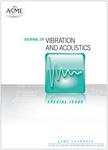版权所有:内蒙古大学图书馆 技术提供:维普资讯• 智图
内蒙古自治区呼和浩特市赛罕区大学西街235号 邮编: 010021

作者机构:Ecole Polytech Fed Lausanne Inst Engn Mech CH-1015 Lausanne Switzerland
出 版 物:《JOURNAL OF VIBRATION AND ACOUSTICS-TRANSACTIONS OF THE ASME》 (美国机械工程师学会汇刊: 振动与声学杂志)
年 卷 期:2014年第136卷第3期
页 面:031005-031005页
核心收录:
学科分类:08[工学] 0802[工学-机械工程] 0801[工学-力学(可授工学、理学学位)] 0702[理学-物理学]
主 题:wave propagation Biot's theory poroelasticity cellular solids band structure fluid-structure interaction
摘 要:This paper presents a detailed study of the pressure waves and effective mechanical properties of a closed-cell cellular solid with entrained fluid. Plane-harmonic-waves are analyzed in a periodic square with a finite-element model of a representative-volume element, which explicitly considers fluid-structure interactions, structural deformations, and the fluid dynamics of entrained fluid. The wall, cavity, and coupled-system resonance frequencies are identified as key parameters that describe the propagation characteristics. A tube-piston model based on computed microstructural deformations allows us to determine the effective stiffness tensor of an equivalent continuum at the macroscale. The analysis of dispersion surfaces indicates a single isotropic pressure mode for frequencies below resonance of the lattice walls, unlike Biot s theory which predicts two pressure modes. Shear modes are instead strongly anisotropic for all values of relative density rho* describing both cellular rho* = 0.3. The dependence of the pressure wave phase velocity on the relative density is analyzed for varying properties of the entrained fluid. Depending on the relative density and mass coupling of the solid and fluid phases, the microstructural deformations can be of three types: bending, through-the-thickness, and the combination of the two. For heavy and stiff entrained fluid, the bending regime is confined to extremely small values of relative density, whereas for light fluid such as a gas, deformations are of the bending-type for rho* 0.1. Through-the-thickness deformations appear only for the heavy entrained fluid for large values of rho*.